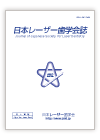21 巻, 3 号
選択された号の論文の11件中1~11を表示しています
- |<
- <
- 1
- >
- >|
学術論文
-
2010 年 21 巻 3 号 p. 141-148
発行日: 2010/12/01
公開日: 2013/04/24
PDF形式でダウンロード (1042K) -
2010 年 21 巻 3 号 p. 149-156
発行日: 2010/12/01
公開日: 2013/04/24
PDF形式でダウンロード (1239K) -
2010 年 21 巻 3 号 p. 157-160
発行日: 2010/12/01
公開日: 2013/04/24
PDF形式でダウンロード (461K) -
2010 年 21 巻 3 号 p. 161-168
発行日: 2010/12/01
公開日: 2013/04/24
PDF形式でダウンロード (1473K) -
2010 年 21 巻 3 号 p. 169-172
発行日: 2010/12/01
公開日: 2013/04/24
PDF形式でダウンロード (935K) -
2010 年 21 巻 3 号 p. 173-178
発行日: 2010/12/01
公開日: 2013/04/24
PDF形式でダウンロード (416K) -
2010 年 21 巻 3 号 p. 179-184
発行日: 2010/12/01
公開日: 2013/04/24
PDF形式でダウンロード (1130K) -
2010 年 21 巻 3 号 p. 185-191
発行日: 2010/12/01
公開日: 2013/04/24
PDF形式でダウンロード (838K) -
2010 年 21 巻 3 号 p. 192-196
発行日: 2010/12/01
公開日: 2013/04/24
PDF形式でダウンロード (560K) -
2010 年 21 巻 3 号 p. 197-202
発行日: 2010/12/01
公開日: 2013/04/24
PDF形式でダウンロード (433K) -
2010 年 21 巻 3 号 p. 203-210
発行日: 2010/12/01
公開日: 2013/04/24
PDF形式でダウンロード (982K)
- |<
- <
- 1
- >
- >|
